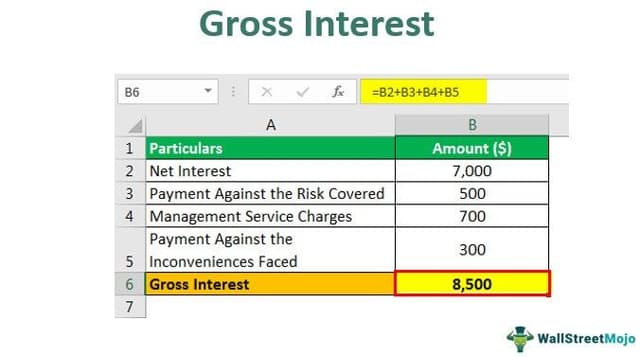Table Of Contents
Gross Interest Meaning
Gross Interest is the interest that is to be paid to the lender by the borrower for using the funds before the deduction of any fees, taxes, and other charges as applicable on it, and it takes into consideration the effect of the payment against the risk covered, management service charges and opportunity cost.
Key Takeaways
- Gross interest provides a clear picture of the total interest earned on an investment before deductions.
- Gross interest is subject to taxes and fees, which can significantly impact the investor's final amount.
- Gross interest is a starting point for calculating net or after-tax returns.
- When comparing investment options, it is crucial to consider both the gross interest and the net interest. While a higher gross interest may initially seem attractive, the net interest reflects the actual amount received.
Components/Elements of Gross Interest
There are different components of the gross interest which are mentioned as below:
#1 - Net Interest
Net Interest, also known as the pure interest, refers to the payment received by the lender exclusively against the use of its capital by the borrower. It does not take into consideration the payment against the risk covered, management service charges, and payment against the inconveniences faced.
#2 - Payment Against the Risk Covered
When the person lends his money to another person, then with such lending, the risk of no-payment of the interest and principal amount on time gets attached. Thus for such risk, generally, the lender charges an extra amount from the borrower above the interest against the use of the capital.
#3 - Management Service Charges
When the funds are given to the borrower, then the lender has to manage such lending activity, which involves the payment made to complete the legal formalities, maintain the records of all the transactions involved related to borrowing activity, sending the reminder to the borrowers, etc. For this extra cost, the lender charges the extra money from the borrower, who is included in the gross interest.
#4 - Payment Against the Inconveniences Faced
Once the funds are given to the borrower by the lender, then the lender will lose the amount which he could have earned if the money is invested somewhere else, i.e., liquidity of capital will no longer be available with the lender. Also, the value of money declines with time. Thus some of the inconveniences are faced by the lender, and for the same, he charges an extra amount from the borrower.
The Hargreaves Lansdown provides access to a range of investment products and services for UK investors.
How to Calculate Gross Interest?
The gross interest can be calculated as below:
Gross Interest = Net Interest + Payment Against the Risk Covered + Management Service Charges + Payment against the Inconveniences Faced

Examples of Gross Interest
Below are examples of gross interest.
Example #1
Mr. A lends the money to Mr. B, amounting to $100,000 against the receipt of the interest. Mr. A receives some sum of money as interest after one year of lending from Mr. B, which is divided into the following different categories:
- Net Interest exclusively against the use of the capital by the borrower: $ 7,000
- Payment against the risk covered for non-payment by the borrower: $500
- Management service charges: $700
- Payment against the inconveniences faced: $300
Calculate the gross interest received by Mr. A for the period under consideration.
Solution
Calculation of the Gross Interest Received by Mr. A

- = $7,000 + $500 + $700 + $300
- Gross Interest = $8,500
Example #2
A sum of $ 500,000 is borrowed by company A ltd from company B Ltd. Company B ltd decided that it will receive 3% of the sum borrowed against the net interest portion and 1% each against the risk covered, management service charges, and opportunity cost. Calculate the gross interest received by company B ltd for the period under consideration.
Solution
Net Interest

- =$500000*3%
- =$15000
Similarly, we can calculate for remaining payments

- Payment against Net Interest = Sum Borrowed * Rate of Net Interest
- = $500,000 * 3%
- Payment against Net Interest =$15,000
Now, Interest received for risk covered, management service charges, and opportunity cost is 1% each on the sum borrowed, which is equal to:
- =$500,000 * 1%
- = $5,000
Calculation of the Gross Interest Received by B ltd

- = $15,000 + $5,000 + $5,000 + $5,000
- Gross Interest = $30,000
Difference Between Gross Interest and Net Interest
- It takes into consideration the payment against the risk covered, management service charges, and payment against the inconveniences faced. In contrast, net interest does not consider the effect of the same as net interest is the payment against the pure use of the capital of the lender by the borrower.
- It is the wider concept when compared with the net interest, as it includes many of the parts. Thus the gross interest includes the net interest.
Conclusion
Thus gross interest is the interest that the lender charges from the borrower for allowing the use of the money of the lender by the borrower. However, it is the wider concept when compared with the net interest as it takes into consideration the effect of the payment against the risk covered, management service charges, and payment against the inconveniences faced. In contrast, net interest does not consider the effect of the same as net interest is the payment against the pure use of the capital of the lender by the borrower.
Disclosure: This article contains affiliate links. If you sign up through these links, we may earn a small commission at no extra cost to you.


